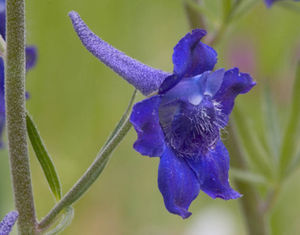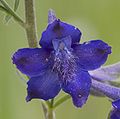Difference between revisions of "Delphinium nuttallii"
(→Seed) (Tag: VisualEditor) |
|||
| (31 intermediate revisions by 5 users not shown) | |||
| Line 1: | Line 1: | ||
| − | ''''' | + | * Scientific Name: ''Delphinium'' ''nuttallii'' |
| + | * Family: Ranunculaceae | ||
| + | * Common Names: Nuttall's larkspur | ||
| + | * Codon: DELNUT | ||
| + | ---- | ||
| + | [[File:DENU.jpg |thumb|Photo by Rod Gilbert, 2004. Also featured on Main Page.]] | ||
| + | === Taxonomy=== | ||
| + | {{Taxobox | ||
| + | | name = | ||
| + | | image = | ||
| + | | image_alt = Delphinium nuttallii | ||
| + | | image_caption = Photo by Rod Gilbert, 2004. Also featured on Main Page. | ||
| + | | regnum = [[Plant]]ae | ||
| + | | subregnum = Viridiplantae | ||
| + | | phylum = Tracheophyta | ||
| + | | subphylum= Spermatophytina | ||
| + | | classis = Magnoliopsida | ||
| + | | subclassis = Ranunculanae | ||
| + | | ordo = Ranunculales | ||
| + | | familia = Ranunculaceae | ||
| + | | genus = ''Delphinium'' L. | ||
| + | | species = '''''Delphinium nuttallii''''' A. Gray | ||
| + | | binomial = | ||
| + | | binomial_authority = | ||
| + | | subspecies = '''''Delphinium nuttallii'' ssp. ''nuttallii''''' A. Gray<br /> | ||
| + | '''''Delphinium nuttallii'' ssp. ''ochroleucum''''' (Nutt.) Warnock | ||
| + | }} | ||
| + | <ref>Integrated Taxonomic Information System. Retrieved from https://www.itis.gov/servlet/SingleRpt/SingleRpt?search_topic=TSN&search_value=18484</ref> | ||
| − | === | + | ===Description=== |
| − | + | Perennial herb with spurred, bluish-purple flowers growing from tuberous roots, up to 60 cm tall.<ref name=":0">WTU Herbarium, Burke Museum, & University of Washington. Retrieved from http://biology.burke.washington.edu/herbarium/imagecollection/taxon.php?Taxon=Delphinium%20nuttallii</ref> Stems unbranched, eglandularly puberulent.<ref name=":0" /> Leaves alternate,<ref name=":2">Hitchcock, C. L., Cronquist, A., Giblin, D., & Legler, B. et al. (2018). ''Flora of the Pacific Northwest: an'' illustrated manual''. Seattle: University of Washington Press. p. 89-92.''</ref> dissected 3-4 times into narrow segments. Inflorescences compact-racemose, many flowered,<ref name=":2" /> simple to compound.<ref name=":0" /> Flowers zygomorphic; sepals 5, uppermost being prominently spurred; petals blue with dark veining,<ref>Bowcutt, F., & Hamman, S. (2016). ''Vascular Plants of the South Sound Prairies''. p. 98.</ref> two unequal pairs (4 petals), upper pair spurred; many stamens;<ref name=":2" /> pistils 3, simple, becoming 3 bent follicles, 15 mm long.<ref name=":0" /> | |
| + | ===Bloom Period=== | ||
| + | May-June.<ref name=":0" /> | ||
| − | + | ===Distribution=== | |
| − | == | + | Pierce and eastern Grays Harbor Counties, Washington, south to the Columbia River Gorge and Clackamas County, Oregon.<ref name=":0" /> |
| + | ===Habitat=== | ||
| + | Gravel outwash prairies, basaltic cliffs.<ref name=":0" /> | ||
| − | + | ===Uses=== | |
| − | + | Landscaping-Not very easy to grow, but looks like it will reseed itself.<ref name=":1" /> | |
| − | + | ===Propagation=== | |
| − | + | ||
| − | + | ||
| − | + | ||
| − | + | ||
| − | + | ||
| − | + | ||
| − | + | ||
| − | + | ||
| − | == | + | |
| − | + | ||
| − | + | ||
| − | + | ||
| − | + | ||
| − | + | ||
| − | + | ||
| − | + | ||
| − | + | ||
| − | + | ||
| − | + | ||
| − | + | ||
| − | + | ||
| − | + | ||
| − | + | ||
| − | Landscaping-Not very easy to grow, but looks like it will reseed itself. | + | |
| − | ==Propagation== | + | |
Extended cold, moist stratification is needed. Cool spring temperatures may also be necessary. In trials at the Pullman PMC, no germination occurred without stratification and no seed germinated after 30 days cold, moist stratification. Seed sown in late December and left outside did not germinate the first season, but germinated well after a second winter. Seed sown outdoors in November will germinate the following spring. Seedlings which germinated outside died when placed in the greenhouse. | Extended cold, moist stratification is needed. Cool spring temperatures may also be necessary. In trials at the Pullman PMC, no germination occurred without stratification and no seed germinated after 30 days cold, moist stratification. Seed sown in late December and left outside did not germinate the first season, but germinated well after a second winter. Seed sown outdoors in November will germinate the following spring. Seedlings which germinated outside died when placed in the greenhouse. | ||
| + | Transplanting was done in early May by using an electric drill and portable generator to drill 1.5 inch diameter holes at the planting site. Plugs must be handled carefully to protect roots. Growth after transplanting is minimal and the plants will be dormant by late June. The following year they grow vigorously and may flower. | ||
| + | The perennating organ is a fleshy fascicled portion of the root near the soil surface. These roots can be removed from the containers in the fall while dormant and outplanted to the field. 4 year old roots thus handled averaged 13.98 mm wide at the widest point and weighed an average of 0.526 grams when outplanted.<ref name=":1">Native Plant Network Propagation Protocol. Retrieved from https://npn.rngr.net/renderNPNProtocolDetails?selectedProtocolIds=ranunculaceae-delphinium-2192</ref> | ||
===Seed=== | ===Seed=== | ||
| − | |||
'''Seed sample from:''' 2011 | '''Seed sample from:''' 2011 | ||
| Line 53: | Line 60: | ||
'''Shape:''' Usually broader at hilum end, bud seeds variable. Seeds in baggy seed coat that sometimes makes seeds appear winged around the edges. | '''Shape:''' Usually broader at hilum end, bud seeds variable. Seeds in baggy seed coat that sometimes makes seeds appear winged around the edges. | ||
| − | '''Color:''' Inner seed dark brown to black, | + | '''Color:''' Inner seed dark brown to black, seed coat white and transparent. |
'''Surface:''' Seed coat finely longitudinally striate and glossy. | '''Surface:''' Seed coat finely longitudinally striate and glossy. | ||
| − | '''Could be confused with:''' Delphinium menziesii. | + | '''Could be confused with:''' ''Delphinium menziesii.'' |
'''Latitudinal Cross Section:''' obovate [[File:DENU lat.png]] | '''Latitudinal Cross Section:''' obovate [[File:DENU lat.png]] | ||
| Line 63: | Line 70: | ||
'''Longitudinal Cross Section:''' semi circular | '''Longitudinal Cross Section:''' semi circular | ||
| − | ==Photo Gallery== | + | ===Photo Gallery=== |
| − | ==References== | + | <gallery> |
| + | File:DENU RodGilbert flw2 good.jpg|Photo: Rod Gilbert, 2004 | ||
| + | File:DELNUT2.jpg|Photo: Rod Gilbert, 2005 | ||
| + | File:DELNUT1.png|Seedling, courtesy of CNLM | ||
| + | </gallery> | ||
| + | |||
| + | ===References=== | ||
| + | *[http://plants.usda.gov/java/profile?symbol=DENU3 plants.usda.gov ''Delphinium nuttalli''] | ||
| + | *[http://biology.burke.washington.edu/herbarium/imagecollection.php Burke Herbarium] | ||
| + | *[http://www.wildflower.org/plants/result.php?id_plant=DENUO Wildlower.org] | ||
| + | <references /> | ||
Latest revision as of 10:50, 8 November 2021
- Scientific Name: Delphinium nuttallii
- Family: Ranunculaceae
- Common Names: Nuttall's larkspur
- Codon: DELNUT
Contents
Taxonomy
| Scientific classification | |
|---|---|
| Kingdom: | Plantae |
| Subkingdom: | Viridiplantae |
| Phylum: | Tracheophyta |
| Subphylum: | Spermatophytina |
| Class: | Magnoliopsida |
| Subclass: | Ranunculanae |
| Order: | Ranunculales |
| Family: | Ranunculaceae |
| Genus: | Delphinium L. |
| Species: | Delphinium nuttallii A. Gray |
| Subspecies: | Delphinium nuttallii ssp. nuttallii A. Gray Delphinium nuttallii ssp. ochroleucum (Nutt.) Warnock |
Description
Perennial herb with spurred, bluish-purple flowers growing from tuberous roots, up to 60 cm tall.[2] Stems unbranched, eglandularly puberulent.[2] Leaves alternate,[3] dissected 3-4 times into narrow segments. Inflorescences compact-racemose, many flowered,[3] simple to compound.[2] Flowers zygomorphic; sepals 5, uppermost being prominently spurred; petals blue with dark veining,[4] two unequal pairs (4 petals), upper pair spurred; many stamens;[3] pistils 3, simple, becoming 3 bent follicles, 15 mm long.[2]
Bloom Period
May-June.[2]
Distribution
Pierce and eastern Grays Harbor Counties, Washington, south to the Columbia River Gorge and Clackamas County, Oregon.[2]
Habitat
Gravel outwash prairies, basaltic cliffs.[2]
Uses
Landscaping-Not very easy to grow, but looks like it will reseed itself.[5]
Propagation
Extended cold, moist stratification is needed. Cool spring temperatures may also be necessary. In trials at the Pullman PMC, no germination occurred without stratification and no seed germinated after 30 days cold, moist stratification. Seed sown in late December and left outside did not germinate the first season, but germinated well after a second winter. Seed sown outdoors in November will germinate the following spring. Seedlings which germinated outside died when placed in the greenhouse.
Transplanting was done in early May by using an electric drill and portable generator to drill 1.5 inch diameter holes at the planting site. Plugs must be handled carefully to protect roots. Growth after transplanting is minimal and the plants will be dormant by late June. The following year they grow vigorously and may flower. The perennating organ is a fleshy fascicled portion of the root near the soil surface. These roots can be removed from the containers in the fall while dormant and outplanted to the field. 4 year old roots thus handled averaged 13.98 mm wide at the widest point and weighed an average of 0.526 grams when outplanted.[5]
Seed
Seed sample from: 2011
Average Measurement: 1.8 x 1.2 x 0.8
Measurement Range: L: 1.25 – 2.1, W: 1 – 2, D: 0.5 – 1.2
Features
Shape: Usually broader at hilum end, bud seeds variable. Seeds in baggy seed coat that sometimes makes seeds appear winged around the edges.
Color: Inner seed dark brown to black, seed coat white and transparent.
Surface: Seed coat finely longitudinally striate and glossy.
Could be confused with: Delphinium menziesii.
Latitudinal Cross Section: obovate 
Longitudinal Cross Section: semi circular
Photo Gallery
References
- ↑ Integrated Taxonomic Information System. Retrieved from https://www.itis.gov/servlet/SingleRpt/SingleRpt?search_topic=TSN&search_value=18484
- ↑ 2.0 2.1 2.2 2.3 2.4 2.5 2.6 WTU Herbarium, Burke Museum, & University of Washington. Retrieved from http://biology.burke.washington.edu/herbarium/imagecollection/taxon.php?Taxon=Delphinium%20nuttallii
- ↑ 3.0 3.1 3.2 Hitchcock, C. L., Cronquist, A., Giblin, D., & Legler, B. et al. (2018). Flora of the Pacific Northwest: an illustrated manual. Seattle: University of Washington Press. p. 89-92.
- ↑ Bowcutt, F., & Hamman, S. (2016). Vascular Plants of the South Sound Prairies. p. 98.
- ↑ 5.0 5.1 Native Plant Network Propagation Protocol. Retrieved from https://npn.rngr.net/renderNPNProtocolDetails?selectedProtocolIds=ranunculaceae-delphinium-2192




